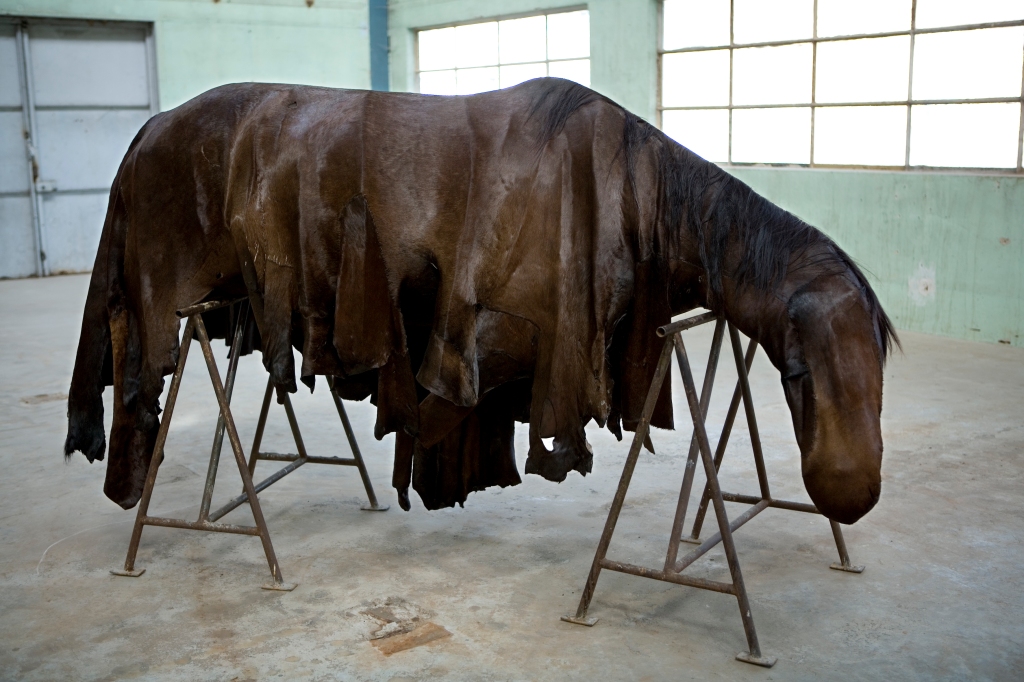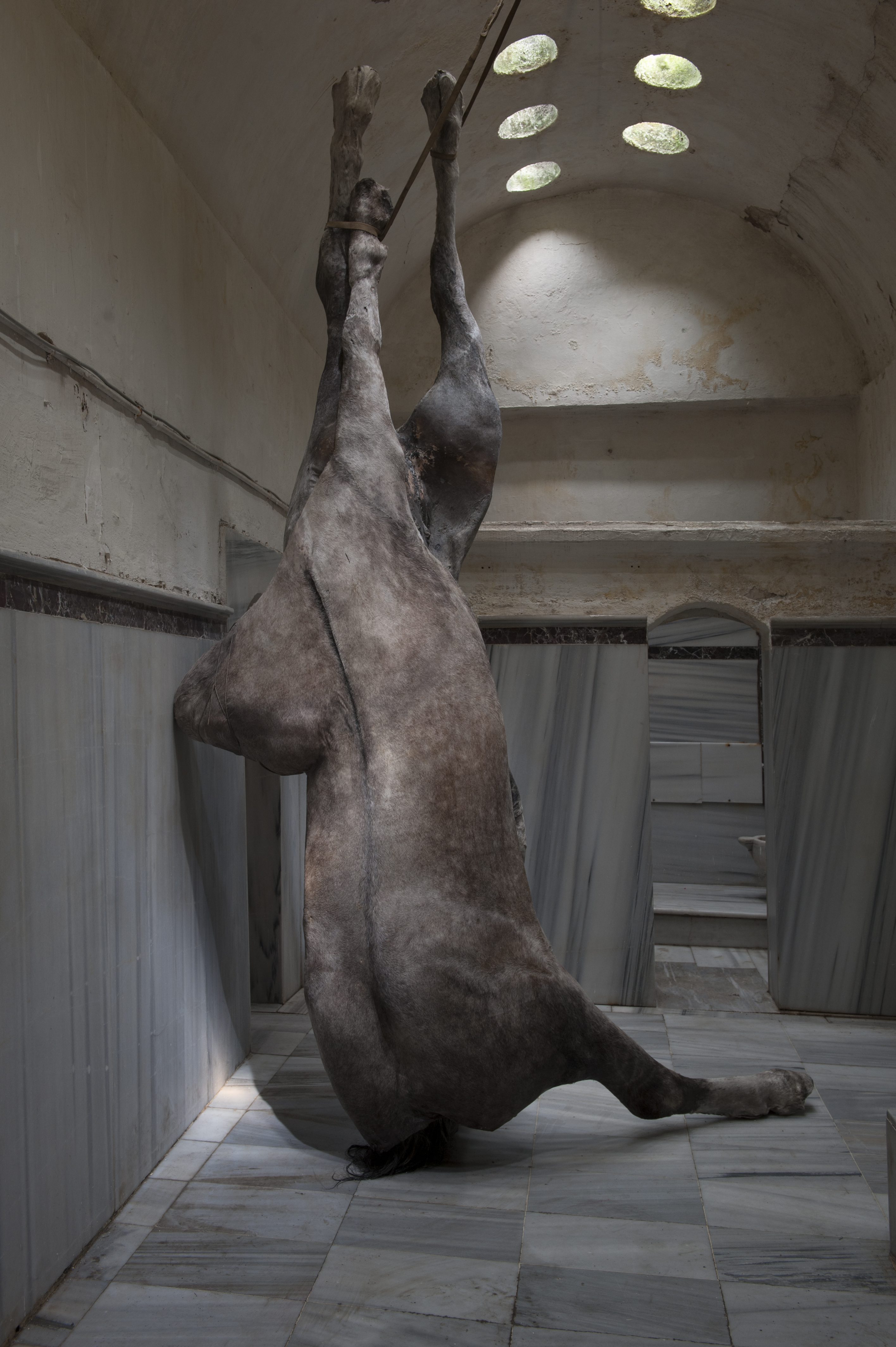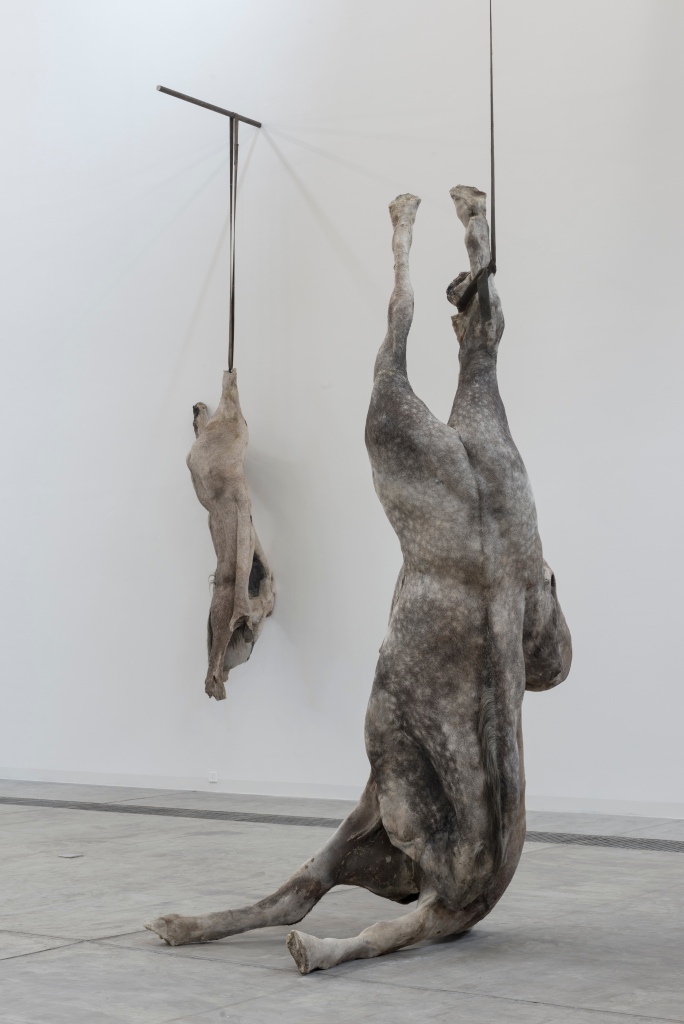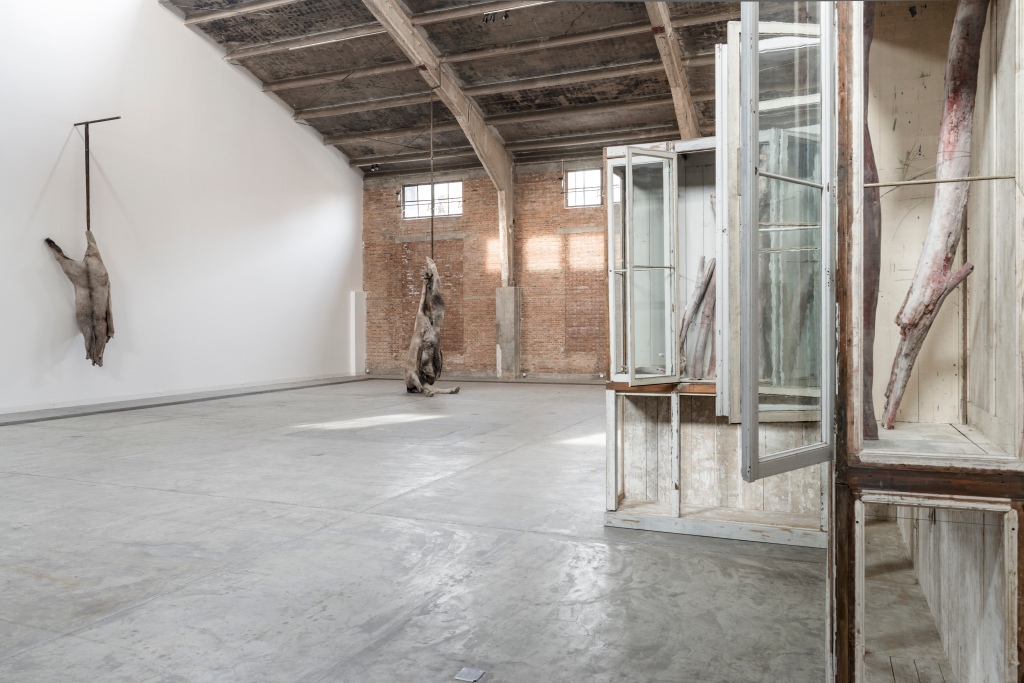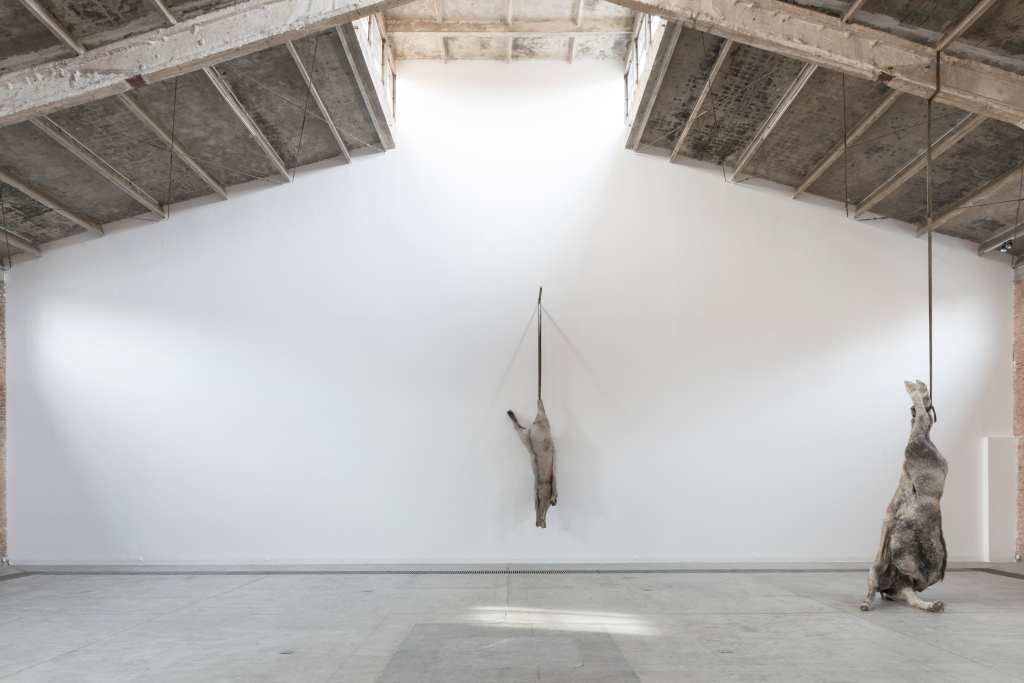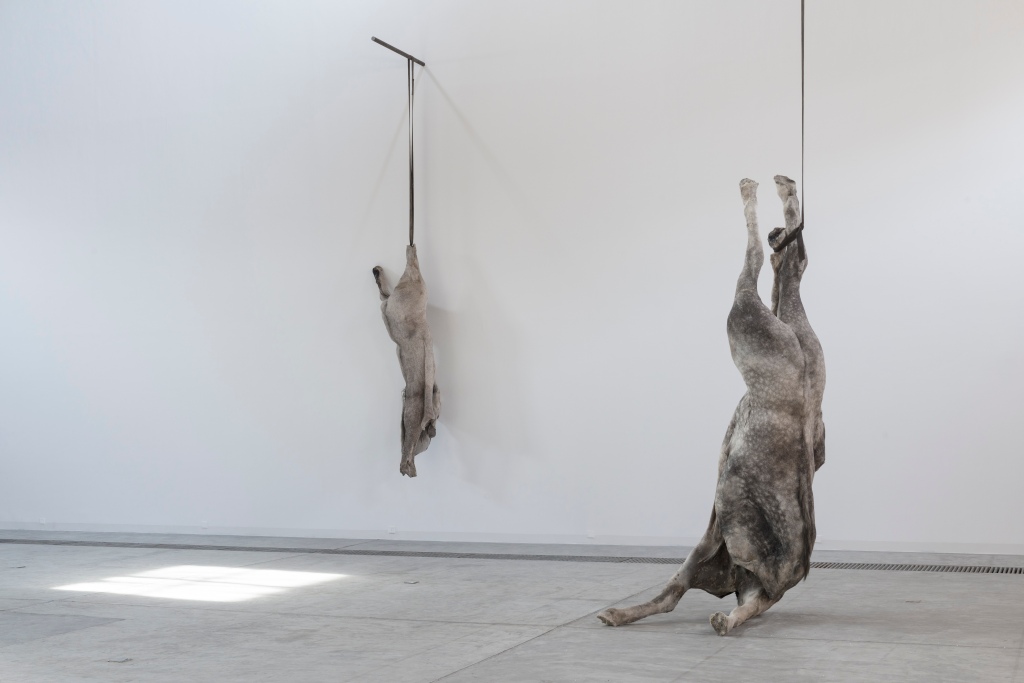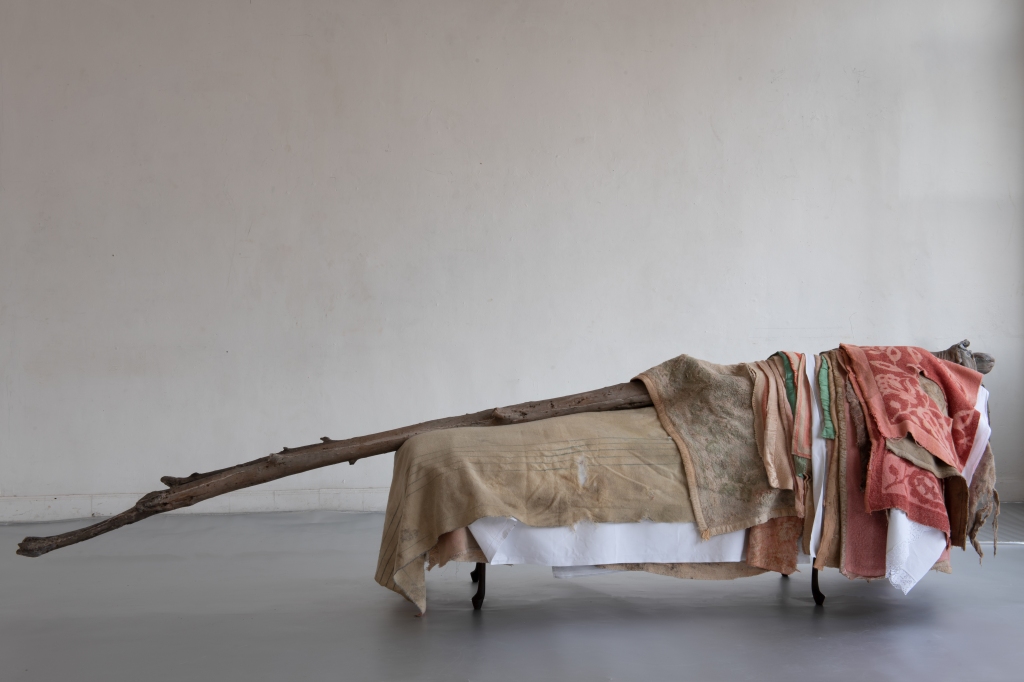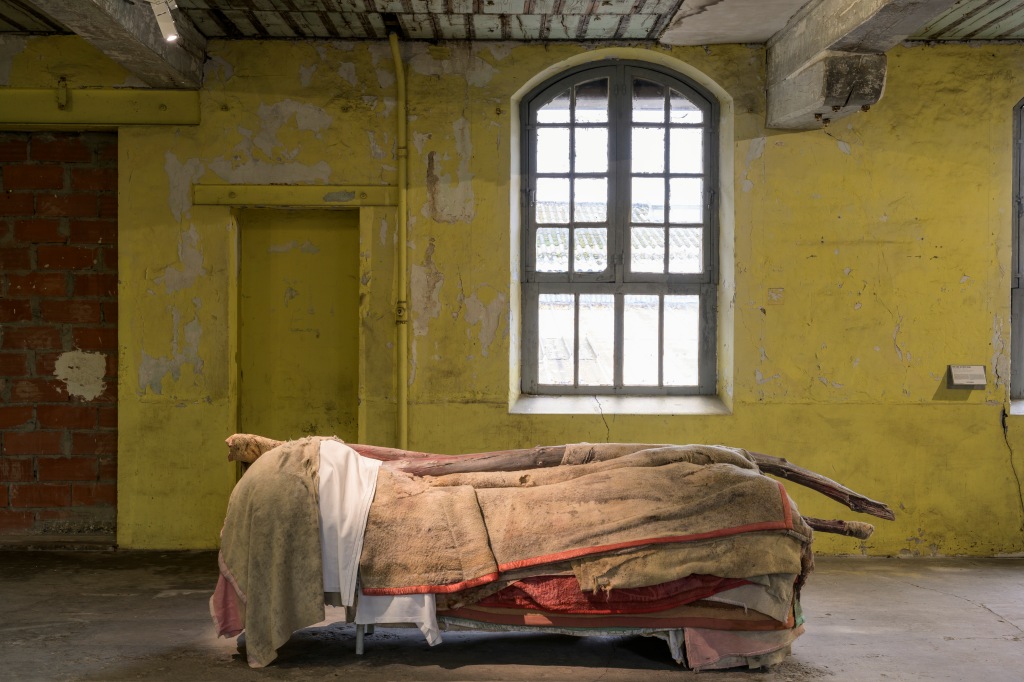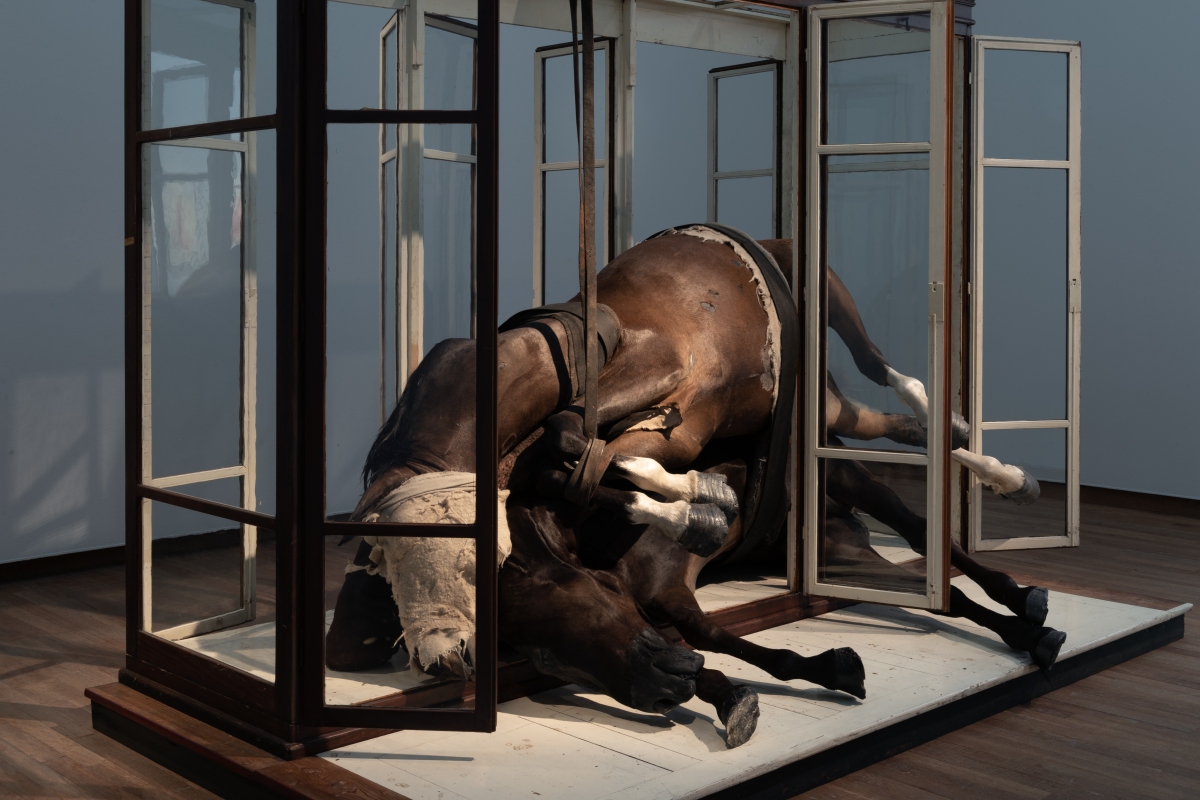by Luca Fiore
To elucidate on the poetics of Berlinde De Bruyckere, who was born in 1964 in Ghent, Belgium, where she lives and works, we have often had to resort to biographical information, such as her being the daughter of a butcher and having grown up in a Catholic context. Even though she became accustomed to seeing quarters of oxen carried on shoulders and bloody scrubs as a child, the artist has always said that her father’s job has not had any influence on the themes she touches upon in her work. More complex and profound, however, is her relationship with religion. She tells us that during her childhood, from the age of five, she lived in a Catholic boarding school. “My first approach to art came from looking at expressions of religious creativity. When I was taken into the institution’s chapel, my attention was drawn not to what was being said or done, but to the sculptures of the saints. I was not so interested in what people they represented, but in the fact that those objects were there, like presences. This deeply affected my sensitivity as a child. It taught me to listen to certain stories and then to see them painted or sculpted. They stayed with me.” During the first ten years of her career, she confides, she never tapped into this reservoir of images. Then, as she began working on the theme of the suffering body in the late 1990s, she inevitably returned to looking at the Great Masters. “You only have to visit one of your wonderful Italian museums to get an idea. How many works, read through a religious or mythological lens, touch on themes of life and death? The art of the Great Masters is like a hook from which I hang my own work, and which allows me to understand more.”
De Bruyckere has absorbed the desire to offer something that can give hope, of showing something beautiful, yet difficult, from Catholicism. “I think of Roger Van Der Weyden’s Pieta, which he says he painted to allow people to mourn the loss of a loved one. I, too, basically want to do something like that.” But the theme of flesh, its suffering and redemption is quintessential of a Catholic sensibility and art. If salvation exists, it must involve not only the spirit, but also the human body. If the possibility of resurrection exists, it must also involve the flesh. And the body of Christ, first crucified and then resurrected, is an image of the destiny of any other body.
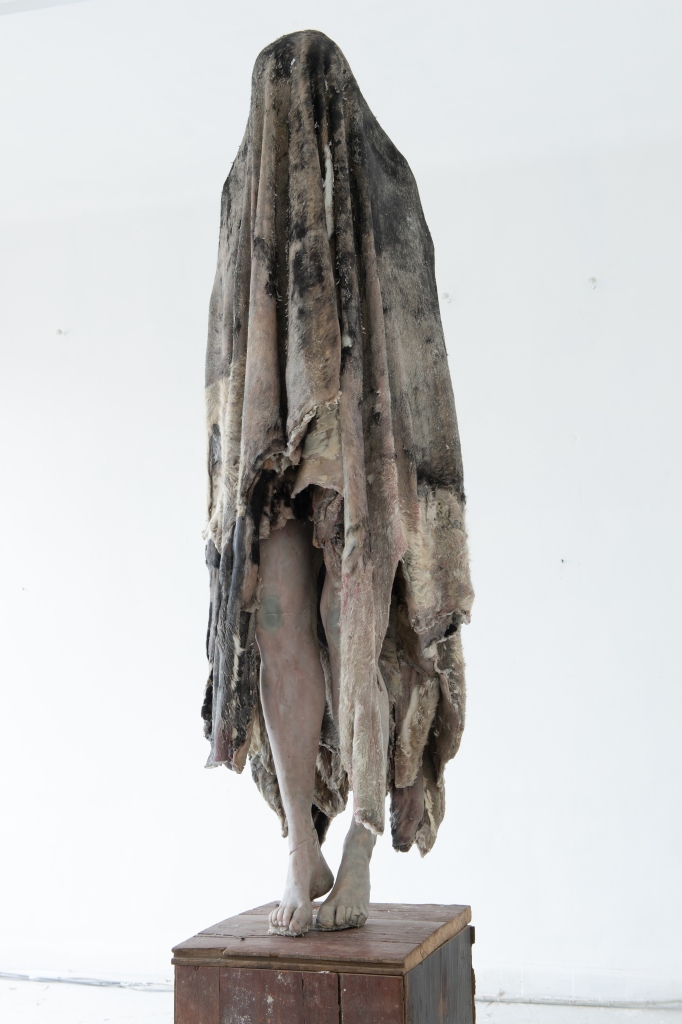
Courtesy The Artist and Galleria Continua
Those who imagine Berlinde De Bruyckere as a sort of dark lady, constantly immersed in thoughts of death, are mistaken. Her vocabulary does not lack words like “joy” or “happiness.” When we ask her about her life as an artist, she sweeps away any doubts: “I feel privileged to do a job that forces me to think about such important and life-related issues. I am a happy person. I have a great family. But in my work I do what helps me as a human being. And it’s very nice to get reactions from people who, in turn, have felt helped.” What sustains her creative energy, she confides, is contact with other people, and the joy of going into her studio every morning and testing her ideas out: “Everything doesn’t always go the way I think it should. Sometimes I fail. What remains is the joy of feeling surrounded by people who try to help me achieve my passion. What also helps me though is what I see on my commute to my studio, or in the news, or in books in my library. There are many sources of inspiration.”
In these days, the Belgian artist is presenting an anthological exhibition at the Bonnefanten Museum in Maastricht entitled “Engelenkeel” (Angel’s Throat), in which she presents, among other things, two new works made during the pandemic: Archangel and Sjemkel. They are female figures, standing on a rough wooden base, covered by a cloak made of cowhide that leaves their bare legs uncovered. The sculptures are made from wax, resin and pieces of authentic leather. “When I visited the churches in Rome as a girl, I was struck by these wonderful creatures placed on the outside of the buildings,” she explains. “I felt they were very significant, both for the theme itself and because of the relationship between the figure and the architecture. I made some drawings and collages of them. I used to collect feathers and attach them to very glossy black paper. But I had never tried to make sculptures out of them.” These figures, almost ghostly, look very much like another cycle of her works made in the late 1990s, in which upright female bodies, made of wax, were hidden under heavy colored blankets. It was the first time that the human figure appeared in the artist’s work, which later became one of the key themes of her poetics. The idea was to create an intimate space, where you could be alone, isolated, with your own thoughts and feelings. “It was interesting to notice the reaction of the models posing for those sculptures. They said they were totally uncomfortable under the covers. Since they couldn’t see who was looking at them, they felt even more naked than they would have had they been completely visible. It’s the relationship between you and me that makes it all the more complicated.”
The external form, the silhouette of those women hidden by the blankets, is very similar to the angels in the Maastricht exhibition. “But when you see them from life,” she explains, “you realize that what looks like a curtain or a blanket is actually wax molded from a mold made of cowhide. This was initially related to the myth of Marsyas, the satyr who, having challenged Apollo on who was more skilled in the arts, was flayed for his pride.”
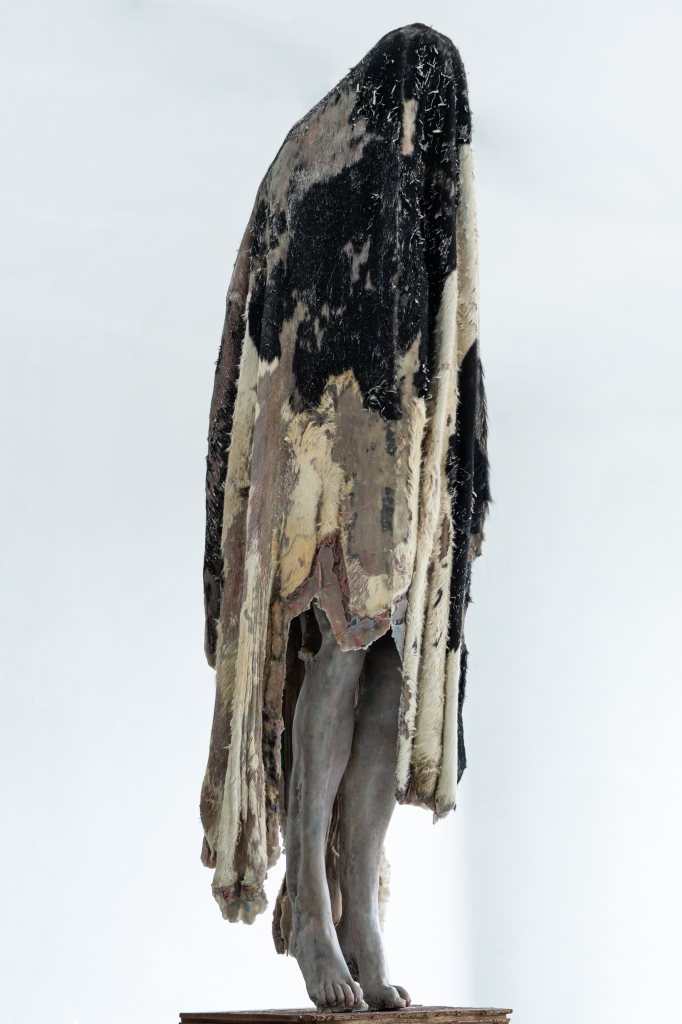
Courtesy The Artist and Galleria Continua
The idea of the angel came to De Bruyckere when a Belgian journalist, at the beginning of the pandemic, asked her what work of art she would like to have in her home at a time when museums were closed and one could not have direct contact with art. “I started looking through my books. Flipping through one on Giorgione, whom I love very much, I found a painting that I had never seen in real life. A dead Christ supported by an angel, which is in a private collection in the United States.” It is a square canvas occupied for the most part by Christ’s naked torso. Behind it is a large-winged angel holding him up. Light comes in from the side and the angel’s cheeks shine. “That’s the image I was looking for!” – she recounts – “it showed what I saw happening around me. People suffering and people, in hospitals, trying to help. It was a time when we were all asking ourselves so many questions. We didn’t know what to do, we didn’t know what was right. There was a lot of fear, we were scared of each other. But, at the same time, I saw people giving their all to do what they could to help those in need. In my eyes, those people had become angels. I thought it was time to address that theme.”
De Bruyckere’s angels diverge greatly from classical iconography. The figures, posed on a high pedestal, suggest, under their heavy leather cloak, the presence of protrusions that could be wings. The asexual beauty of the art of the great masters is not conveyed; there is no narration. Their face is hidden, as it is in all human figures produced by the artist. The reason why the face is absent is that its hairstyle is related to the fashion of the moment, while the naked body is something universal. “Covering the figures allowed me to imagine the wings. It’s something much more intimate. It’s much more connected to a sense of hope. There’s the notion that these creatures might be able to fly. The way I place the sculptures on the base is also designed to make it unclear whether they are flying away or coming to rest on the ground. It’s something you need to feel, not something I decide. Do you wish for them to leave, or to come to help you? Or do you want them to go to someone else?”
Looking back over De Bruyckere’s career, it is evident that the theme of the human figure was touched upon even when tree trunks or the bodies of exhausted horses are depicted. “In 1999 I worked at the In Flanders Fields Museum in Ypres, which is entirely dedicated to the events of the First World War. There I exhibited five life-size portraits of dead horses, made by stitching real leather. The shape of those corpses is a very powerful metaphor for death. It rendered the idea that we are dealing with something larger than the size of our bodies. After seeing a work like that, we will look at a suffering body differently.”
The 2011 series “Into One-Another” in fact dealt with suffering and mangled limbs, in which the artist began to fuse together pieces of naked human bodies made of wax, so that each part seemed to grow from the other. The theme was also picked up on later using horses. It’s certainly a sexual metaphor, but for the artist it is also related to the process of metamorphosis: “It’s about something arising out of something else and becoming bigger and more important.”
What is most destabilizing about De Bruyckere’s work is that the theme of death and suffering of the body is inextricably intertwined with that of beauty, which, as is her intention, appears necessary to deal with decay, anger and fear. “If I leverage beauty, using beautiful, soft and flexible materials such as blankets, horsehide or wax, I can go deeper and achieve greater intensity. If I used bronze or cast iron for my sculptures, which are cold elements, the viewer would be drawn away from the theme. I make use of what people like to touch. Fragile elements.” The dimension of beauty is also linked to silence, “which is what comes immediately after the incomprehensible moment of death. After the suffering of a body, even that of a horse, there is a silent pause, which is very helpful in trying to understand and find calm. The last moments of life are the most difficult, you feel that you don’t want to leave and that you want to keep living. They can be moments of struggle, even aggression. But when it’s all over, silence comes. Very often in my works you can see both struggle and calm at the same time.” But the most scandalous aspect of these works emerges when beauty becomes sensual and is contaminated with a sense of the end: Eros and Thanatos. De Bruyckere is aware of the presence of this figure in her work. “With Thanatos there is silence, while with Eros there is passion and life. They are the opposite of each other, but both are deeply rooted in us. We are always thinking about life and love, but also about death. This is not a duality that I am interested in intentionally bringing out. It appears because it comes from the deepest part of me.”
We all suffer, we all die. And we are all aware of it. But shouldn’t art say something we don’t already know? And yet, addressing such a theme has a sting to it, rubbing salt into the wound. If we don’t know why we die, it’s difficult to give ourselves an answer as to why we live. No one is interested in quick answers. To deal with the theme of death is to confront the great mystery of life.
A few weeks ago, De Bruyckere placed a sculpture, Honte (2018-2019), in a small chapel in Ghent, which depicts a foal that has survived only one day lying on a large rock. “The work was illuminated by natural light coming in through a stained glass window. At the opening, there were many astonished reactions. They said, ‘It’s so beautiful.’ Yet they were faced with the figure of a dead horse. Nature created something wonderful and, after just twenty-four hours, has deprived it of life.” The animal, the artist explains, lies on a large stone. “I see this dialogue between the boulder that took millennia to form and the fragile and wonderful animal that lived just a few hours, lying with its eyes closed with its hoofs on its face, as if to protect itself. It shows no signs of suffering, so much so that someone thought it was sleeping. I like that the position of the animal insinuates this doubt: is it dead or asleep? It depends, perhaps, on a certain kindness that I try to give to my sculptures. But more than kindness, I would say softness.”
Instinctively, De Buyckere’s work has come to be likened to Alberto Burri’s “sacks” and Francis Bacon’s bodies. “With regards to Burri, I think we are united by the sense of fragility that the material used communicates, although recent works made with blankets come from another idea.” After using them as an image of shelter and protection, over the past decade, the artist has tried leaving them outdoors for months or years to expose them to the elements. “Nature is my silent worker. Using this type of fabric fits better with my way of thinking today. Time has transformed the material. And also the way I understand it. The social context has completely changed since the 1990s. Today we are no longer able to protect people, to offer them help. We abandon and let those who cross the sea die.”
A comparison with Bacon has accompanied De Bruckere for years and, she confides, she does not particularly appreciate the work of the great English painter. “At first I was annoyed by it. But the fact that they kept comparing me to him led me to wonder if there really was a relationship. We actually have several things in common.” One of them, she explains, is twisting bodies, deforming them. The other is the way she depicts skin and flesh. “But there’s also another aspect: Bacon presented his paintings behind glass and with large gold frames. I think because his themes are so strong and direct, he felt the need to place something between the work and the viewer. It’s a bit like what I do with display cases to protect horses or human bodies. It’s a filter between the viewer and the fragility of the sculpture.”
There is another artist to whom De Bruyckere feels she owes a great deal: the 16th-century German painter Lucas Cranach the Elder. For a long time, she says, she produced drawings from his paintings, interested in the way he deformed figures and the way he rendered flesh tones. The painterly quality of her sculptures, she says, came from him. “Another artist who has influenced my poetics is Pier Paolo Pasolini. The Into One-Another series came about because I was working with my team on his work to find aspects to translate into sculpture. I love the fact that he worked with his friends, his lovers, his own mother and had them act in his films. It’s a bit like working in my studio, where we have become one big family. We hang out, we know each other’s children, we love each other and help each other. It’s a very nice way to work, even if it’s challenging. I don’t just have my family, I have something bigger to take care of. Working in a studio is not just doing your job, everyone takes charge of the works that are created, like real things, not like fairy tales.”
Her next big project is an exhibition at Palazzo Pitti, in the spaces of the Uffizi. The exhibition is scheduled for next November. To work on the project, De Bruyckere will have to go to Florence several times. “Some of my works arise in relation to the work of the old masters, others do not. I’m interested in perceiving whether my most recent works have any connections to the masterpieces of the past. It’s an opportunity that rarely happens in life and I want to give it my all.”
